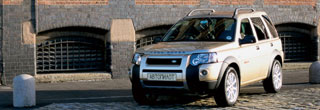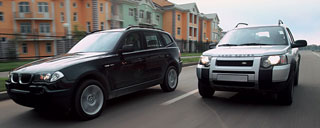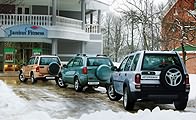Test drive Land Rover Freelander 2003 - 2007 SUV
Cars from Mars
The book of a woman from Venus, men from Mars are devoted to a psychological abyss between the sexes. So, if you operate with the terminology of this popular science publication, then contrary to the common opinion that crossovers are for girls, updated versions of Ford Maverick and Land Rover Freelander are definitely machines for people from Mars. Despite compactness, they are solid, even slightly brutal and can offer versions with V6 engines.When Land Rover Freelander saw the light in 1997, skeptics spoke of the degeneration of the great spirit of the legendary company. In fact, it was unprecedented: a compact supporting body, a completely independent suspension, the absence of a demultiplier, a front-wheel drive with an automatic connection of the rear axle over the Wi-Muft ... But the success of Frelander turned out to be phenomenal. The crossover for several years occupied the highest lines in charts around the world and in the worst tests showed himself from the best side.
Designing the Maverick crossover, sold in the USA and Canada called Escape, the Ford Motor Company proceeding from the fact that America needs a light youthful SUV that could recapture a tidbit of a market cake from stupid Japanese. Its first samples went off the assembly line of the company in Kansas City to the Millennium itself, thus marking a kind of shift in the car consciousness of the United States. However, the Americans, as usual, did a lot in their own way. The crossover looked larger than he actually was, and received the largest and least forced motor among classmates, and a 4-speed assault rifle handle stuck out from under the steering wheel. Late for several years, Ford Maverick did not gain dizzying glory, but was sold evenly and, having undergone a thorough modernization this year, claims to be well -deserved success.
Land Rover Freelander was updated last year, and this concerned mainly running qualities and appearance. You might even say that the template that crossovers modernized is the same for both. However, this is not surprising, because Land Rover is part of Ford Corporation. After restyling, the cars received multi -reflex headlights, more clearly drawn rear lights, new bumpers, discs and colors.
Based on the fact that a crossover is a car located in two wheels in a camp of cars with a sports character, two more in the off -road segment of the market, and the reserve is at the position of family station wagons, then the Land Rover gravitates, and Ford - Ford more to the disposal . The muscular body of Freelander with a proprietary stepped roof and covering the front wings with a profiled hood, released by extensors of wheel arches and characteristic skis in the lower part of the bumper unequivocally hints that its habitat is off -road. Let not as serious as Defender, but still. Ford is more restrained and, despite the developed plastic protection of doors and spikes made of unpainted material, makes you think more about the long road, vacation and carriage of baggage, although this vacation is seen in places where without snowboarding, kayak, or at least fishing gear, not Get out. In a word, Maverick is more like a family car than Frelander. The interior only confirms our conclusion.
Clock paradoxes
The contrasts of the Land Rover salon finish resemble a sports clock, a sort of extreme option with a compass, an altimeter and bright green backlight. A hypothetical chronograph from Ford looks more restrained. It must certainly be a turnout, with a classically designed dial and soft amber backlight ... And here's another. None of the salons causes associations with expensive Swiss devices designed to show not only time, but also the status of the owner - the rigid plastics used in the decoration look quite modest. But at the same time, the seats in Maverick are covered with perforated skin, and Freelander has a combination of the skin and the softest suede. As for the characteristics that do not require special fantasies, that is, comfort for the driver and passengers, the ergonomics of the workplace, the variety of places for storing trifles, a cargo compartment and electronics, then each of the competitors has its own advantages and disadvantages. So, Ford is a little ahead in terms of trunk volume - 555 liters (1550 liters with folded rear seats), versus 546 l (1319 liters with folded rear seats) in Land Rover. But the latter in the middle part of the cabin under the ceiling has nets for small objects, and in the front doors - dimensionless clamps for bottles or even thermos.
Ford door handles are made under a natural grip, and in Land Rover they need to be toned from below, which is not so convenient. The designs of the fifth doors of tested cars are also resolved in a completely different way. The British offer a low, opening gate open to the right with a glass cleaning in it. At Maverick, the door rises entirely, but the glass can be opened separately, which is very convenient in close parking lots at supermarkets. Finally, we must not forget about a possible repair after a collision at low speed. In this case, the Land Rover spare wheel hanging on the rear door will only harm. But if there is a replacement of the wheel on the road, especially on off -road, then I would not want to contact the dirty, or even just inaccessible margin of Maverick, suspended under the bottom.
Driving an American SUV to get a little easier to get a little easier. He has more adjustments to the driver's seat, the position of the pillow is changed by an electric drive. It is a pity that there is no control of the lumbar backup. In general, the Maverick seats are typically American in profile, and in terms of stiffness they approach the European style.
The Englishman is simpler - the back is tilt is carried out by a wheel, the pillow is not separately adjustable, but there is a lumbar backup, and the landing itself is more vertical. Side support is excellent, in such a chair you feel like a real driver before the start of movement. A thick steering wheel, clearly made under a male hand, also helps to create a similar mood. It is only a pity that for long -legged and tall drivers, Land Rover is crowded - the range of movement of the chair along the distance to the pedals is not large enough. However, Ford, although more spacious, is somewhat disproportionately complicated - the steering wheel is further, and the pedals are closer than we would like. At the same time, he, like the opponent, has a steering column only by inclination.
Inexhaustible muffler
The transmission diagrams of tested cars are fundamentally similar - front -wheel drive with connecting the rear wheels through a multi -disc booth. Since this year, Ford sets an electro -hydraulic system with a multi -disc clutch as a coupling, many sensors and complex control. Land Rover is content with a WISK MUFTA, which complements with its own development - the descent control system from the Hill Descent Control hill and an electronic imitation of the second -generation inter -long locks operating on each wheel independently.
The overall dimensions of both models are very close. The Briton is a centimeter shorter than an American and as much higher. Ford has a larger wheelbase, track and clearance (the latter is 203 mm, and the Land Rover has 186 mm), and the parameters of geometric patency, in particular the angles of entry and the congress, are better in Land Rover: 30.5/33.9 versus 19 /27 for Ford. The reserve under the rear overhang Maverick limits the geometry, but Freelander dies the muffler, scaring potential jeepers with its vulnerability. I must say that no one has once yet damaged this detail seriously, although all those who consider themselves experts of off-road poke a finger in it. The maximum permissible angle of the American transverse roll is 49 degrees, the British is 45, the depth of the ford - 600 and 400 mm, respectively, and the angle of overcoming rise in percent is 45 for Ford and 40 for Land Rover.
Well, perhaps, it is enough to theorize, it is time to go to laboratory practice and field work, meaning by the first manageability and behavior of cars on asphalt, and by the second - abilities outside the roads. Many experts in all -wheel drive like to rebuke crossovers in the absence of any off -road potential, in natural fragility, weakness and soreness. We will take the courage to argue that, with a reasonable approach, the cross -country ability of some types of crossovers is not too different from the one that is demonstrated by full -fledged SUVs. And in skillful hands and under certain circumstances, perhaps it does not differ at all. What are crooks afraid of? Rings, weak soil, slippery lift and descent, steep relief fractures - these are the most general examples. We experienced our crossovers for them, having checked the handling on an uneven road, the work of auxiliary systems and transmission.
Workshop on geometry
The speed of the Maverick all -wheel drive is clearly higher than that of Frelander. Sometimes it seems that between the beginning of the rotation of the front and rear wheels of the American there is no time period at all. Together with a painful engine and successful weight distribution, this allows Ford not to feel offended in comparison with a more seriously armed Land Rover, whose pseudo -approval is great in complex areas. In particular, the classic diagonal hanging for Maverick fatal, and for Freelander a formal trifle. If you approach the issue correctly and use inertia, then a slightly larger stroke of the crossover suspension with a blue oval on the false radiator gun equalizes it with an opponent. Nevertheless, the geometric advantages of Land Rover are obvious - when driving along the crossed area, its overhang is much less common with the soil. As for the differences in the clearance, they are ghostly, especially since the obliquely protruding transverse levers of the rear suspension Ford eat those millimeters that are played from the competitor with a large common road clearance. By the way, Land Rover suspension elements look somewhat more powerful and reliable. In addition, Maverick has the bottom and motor compartment from below are not protected at all, and Frelander has a solid plate. When landing on the belly, Ford first of all concerns the ground with a muffler jar, and the Land Rover - the body of the body.
On bumps, on bumps ...
A quick ride on a broken road is more comfortable if you are driving Ford - Frelander noticeably tougher, although any of them have not been noticed by tangible pendants. As for handling on the tubercles and gravel, in principle, Land Rover behaves a little better. Although the Maverick steering is a little more sensitive at the zero position, the Briton on pardins will steer more confidently and damples the bumps better. However, the nuances are so insignificant that they merge in two common, subjective impressions: Ford is more comfortable, Land Rover is more sporty.
This also manifests itself when driving on asphalt. A bunch of fast turns of Freelander is better under the thrust, and Maverick for discharge of gas and with a smooth call. The sensation is enhanced by a tight sports steering wheel and a dense armchair of an English SUV, which provoke hard actions. But if you are closer to a sense of confident non -lazy movement, then you should like Ford. Moreover, in both cases, the difference is manifested only in sensations - in reality, the comfortable speed of turning the turns of Maverick and Frelander is approximately the same. True, if you increase it a little more, then the American gradually begins to pull out, and the front axle will noticeably ahead of the rear and an unpleasant vibration of the breakdown tire will appear. Land Rover in this case crawls entirely.
If you try to reduce the turning radius, then the character of Frelander will change and it will become more like a front -wheel drive car, inclined to demolish the front axle. It will also happen if you put high -profile tires on Land Rover, and now it was 225/55 R17 on it. In case of loss of control, say, on a slippery highway, the Briton is more willing to stretch out with gas, and the American is adjusted by the steering wheel, fortunately, I repeat, he is very sensitive at the very zero. At high speeds, Yankees are a sample! Excellent sound insulation, comfortable suspension and confident course stability give out a marathoner in it. That's just the sound of the motor is some kind of indescribable, unlike Land Rover, who sings, moving from counterattack on the falsetto, is visible and distinctly. The transmission of Ford 4-speed, very soft and fast, and a 5-speed Frelander machine is older and more loaded, but has a sport function that accurately monitors the maximum switching to the maximum to the maximum of power and offers manual gear shifts. True, this cannot compensate for the difference in power. We arranged paired races from a place in different modes, and Ford every time a half -corps was ahead of Land Rover.
Nothing feminine
Returning to the issues of a planetary scale, namely to disputes, who is from Mars and who from Venus, we can say that the crossovers we have experienced do not resemble the so -called female car. Rather, they are suitable for men of middle managerial age (for the youngest it turns out a little expensive) with a small family and restless work. More energetic - Land Rover Freelander, thorough - Ford Maverick. Sports notes in the style, salon and behavior of the British are supplemented by off -road abilities, which in general exactly corresponds to the image of the model. However, a compact business utility from Ford is a conservative only at first glance, hiding a romance and a traveler under a business suit.
SPECIFICATIONS
Ford Maverick: Land Rover Freelander
Length/width/height, mm - 4441/1762/2017/: 4449/1809/1708
Wheel base, mm - 2620/2557
Dor. Line, mm - 203/186
Complete/Shar. mass, kg - 1573/2050/1562/2060
Burner. and number. - V6/V6
Working volume, cm3 - 2966/2497
Max. Power, l. With [Email Protected]rpm - [Email Protected]/[Email Protected]
Max. Twisting, nm@rpm - [Email Protected]/[Email Protected]
Transmission - 4At/5AT
Maximum speed, km/h - 188/182
Acceleration to 100 km/h, s - 10.5/10.5
Average consumption per 100 km, l - 12.1/12.4
Fuel tank volume, L - 62.5/64
Price from 31 750 euros - (~ 38 100 USD)/35 900 USD
Text: Igor Gubar
Source: Magazine 4x4 [12/2004]









